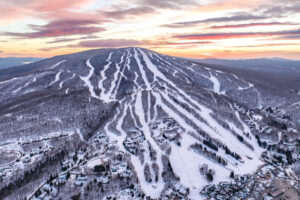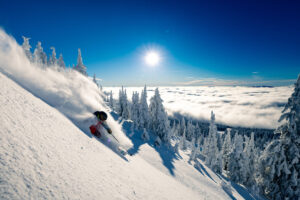Perhaps no question is more important than that of which skis you should buy. Maybe you’ve been renting skis and want to own a pair. Maybe you’re updating skis you’ve had for a while. Or perhaps you’re just adding to your ski quiver. Whatever the situation, the hardest part of buying skis is sorting through the different types, brands, models and sizes to decide which ski is right for you.
Decades ago, skis were long and wooden without much choice in what you got except for length. Ski lengths and the weight of skis have lessened as the decades have passed. Back in the day, the challenge was the lack of choices when buying skis. Now, skis come in different lengths, widths, weights, flex patterns and sidecuts, with hundreds of options to choose from. However, we hope the following ski buying guide can help answer some of your questions about which ski is right for you.
Which Ski Is Right For You?
Before we get into the types of skis, and which type of ski is right for you, it’s important to know a little bit about the terminology and dimensions you’ll see as you’re shopping for skis.
Types Of Skis
The definition of a narrow ski changes from region to region, country to country, and year to year. For example, in Europe, it’s common to find skis in the range of 60-70 mm underfoot classified as carving skis. North Americans tend to classify narrow skis as falling from 70-80 mm underfoot. East coast or Midwest skiers in North America tend to ski on more hardpack conditions and thus favor carving skis or frontside skis.
Mid-fat skis are the bridge between narrow and wide skis. Mid-fat skis are designed to carve short to medium radius turns and handle both groomers and cut-up snow. They tend to run between 85-98 mm underfoot. Skis within this range of waist width are also known as all-mountain skis. Skis with waists over 100 mm underfoot are typically classified as powder skis because the wider surface area underfoot allows the ski to float more efficiently in soft snow.
Ski Shape
In a ski shop you’ll typically hear terms like sidecut, rocker and camber being tossed around, but what exactly do they mean? Sidecut refers to the general shape of the ski. You can view the shape, often in hourglass design, by viewing the bases of the ski. With most skis, the tips and tails are significantly wider than the waist.
Rocker refers to the upward curve in the tip and tail of the ski. Heavily rockered skis have a more pronounced curve that allows them to float better through softer snow. Rocker like this can traditionally be found in powder skis, although some amount of rocker has become more popular in all-mountain skis to make them more versatile. Rocker, or reverse camber, is visible by laying the ski flat on the ground and observing where the entire ski lifts off the ground, typically in the tip or the tip and tail. Camber refers to the arch of the ski found in the center and indicates how much of the ski is making contact with the snow when you ride.
These terms are helpful to know if you want to understand ski construction but not necessary in order to pick a pair of skis that work for you.
Women’s And Men’s Skis
After identifying your ability level (beginner, intermediate, expert) you should consider what kind of terrain you ski. Then you can look at specific categories (again, designated by waist width and intended performance), such as women-specific skis, men’s all-mountain skis, freeride skis, freestyle skis, race skis, park and pipe skis, and powder skis. Remember that the ski you buy should be based on your skiing ability and what type of skiing you enjoy.

Ski Length
Manufacturers generally offer several ski length options for each ski model. Note that the shorter the ski, the faster it will turn, but it may be more unstable at higher speeds. The longer the ski, the better it will track at high speeds but the less responsive it will be in tight turns. Sometimes a ski that is too long means the skier struggles to find the balance point or sweet spot. In the old days, customers were told to reach up their arm and fold their wrist over the ski’s tip to see if it was the correct length. Ski shops use the “third eye” (intuitive perception) these days as a marker, fluctuating above or below according to ability level, ski type, and whether the ski has a significant amount of rocker.
It’s important to note that there is no right or wrong size for each individual skier, but rather a range of sizes that will work best depending on skier ability and where they prefer to spend time on the mountain.
For Beginners
If you’ve just learned how to ski, the best choice (and most affordable) is a pair of skis designed for beginners. These models are made with the same materials and care as higher-end skis, but are generally lighter weight, softer, and easier to maneuver. Beginner skis are sold in shorter lengths so that they’re easier to turn and stop. You can always upgrade from beginner skis later.
For Intermediate Skiers
Intermediate skiers will likely gravitate to all-mountain skis. All-mountain skis are designed to handle almost all on-piste conditions, plus some off-piste conditions. These models often have a rocker in the tip which makes it easy to initiate the turn. They’re designed to handle equally well on ice, groomed runs, and in light powder snow. Budget-minded people looking for one pair of skis often go with all-mountain skis because of their versatility around the mountain.
Freeride Skis
Look to freeride skis if the entire mountain is your playground. Designed to handle all types of snow conditions, freeride skis can lay down arcs on freshly groomed blue runs, cut-up crud off-piste, or float through powder. Typically wider than all-mountain skis, freeride skis are designed for exploring the entire mountain. Some freeride skis have a playful personality while others have a more directional, aggressive personality.

Freestyle Skis
Freestyle skis have continued to grow in popularity thanks to freestyle tours, magazine stories, Warren Miller movies, and the Winter X Games. These skis are designed for take-offs, landing on jumps terrain park and pipe features. Therefore, they are typically a lighter and shorter than other types of skis with twin tips. Twin tips are skis that are evenly curved in the tip and tail to accommodate skiing backward as well as forward.
The main difference between freeride skis and all-mountain skis is that freeride skis are typically wider than all-mountain skis and are designed for exploring more of the mountain.

Racing Skis
Racing skis are appropriate for the highest caliber skiers on the mountain. These skis are designed for responsiveness and speed. Slalom skis have a tight turn radius for quick turns, while giant slalom skis have a larger turn radius to make bigger arcs with speed. Racing skis are generally more expensive because they feature high-end technology. They have a stiffer flex pattern to be able to hold turns at high speed. Recreation or town league racers can find skis that are softer versions of World Cup level race skis. The flex will be more friendly for the general racer, but the model will have reliable edge grip and bases designed for speed. Racing skis will perform best on groomed runs. While they can be taken in bumps and off-piste, that is not where they shine and may be difficult to maneuver in deeper snow.

Powder Skis
Powder skis are the fat and fun skis on the mountain. Wider than other types of skis, they are designed for off-piste skiing and floating through bottomless powder deep snow. Nearly all powder skis have some amount of rocker in the tip and tail, which aids in flotation. Full rockered powder skis have no camber underfoot and are simply designed to do one thing: Float. Be aware, however, that fully-rockered skis are not designed for hard snow performance. The majority of powder skis have a combination of camber underfoot and rocker in the tip and tail, which results in more versatility since the camber underfoot allows the ski to perform on hard snow and not just powder.

Unisex Skis
Most ski companies offer unisex skis and women-specific skis. Sometimes, the difference between unisex and women’s skis are only length options and topsheet designs. However, many women-specific ski models have unique construction attributes that set the skis apart. It’s common for women-specific skis to have a binding mounting position slightly forward than a unisex skis, which helps women find the balance point of the ski. Women’s skis often have a slightly softer flex, which makes the ski easier to bend. Women’s skis may have a lighter construction than the comparable unisex model, which again makes the ski easier to flex and easier to maneuver for women who often are shorter and weigh less than men. Of course, not all women are made the same and plenty of women ski on unisex models instead of women’s skis. There are many choices designed to work for different skier types and terrain choices.
Final Thoughts
New technology has significantly changed the way we ski over the past several decades. Many shops and resorts even have opportunities to demo skis or try them before you buy. Shops will often take the demo price off of the sales price of the ski if you decide to buy it. Some shops and resorts offer demo days where you can try multiple pairs of skis. Inquire about demo days at ski shops or ski resorts. However you find your new pair of skis, there is no doubt that finding the right pair for you will make your day on the slopes infinitely better.





